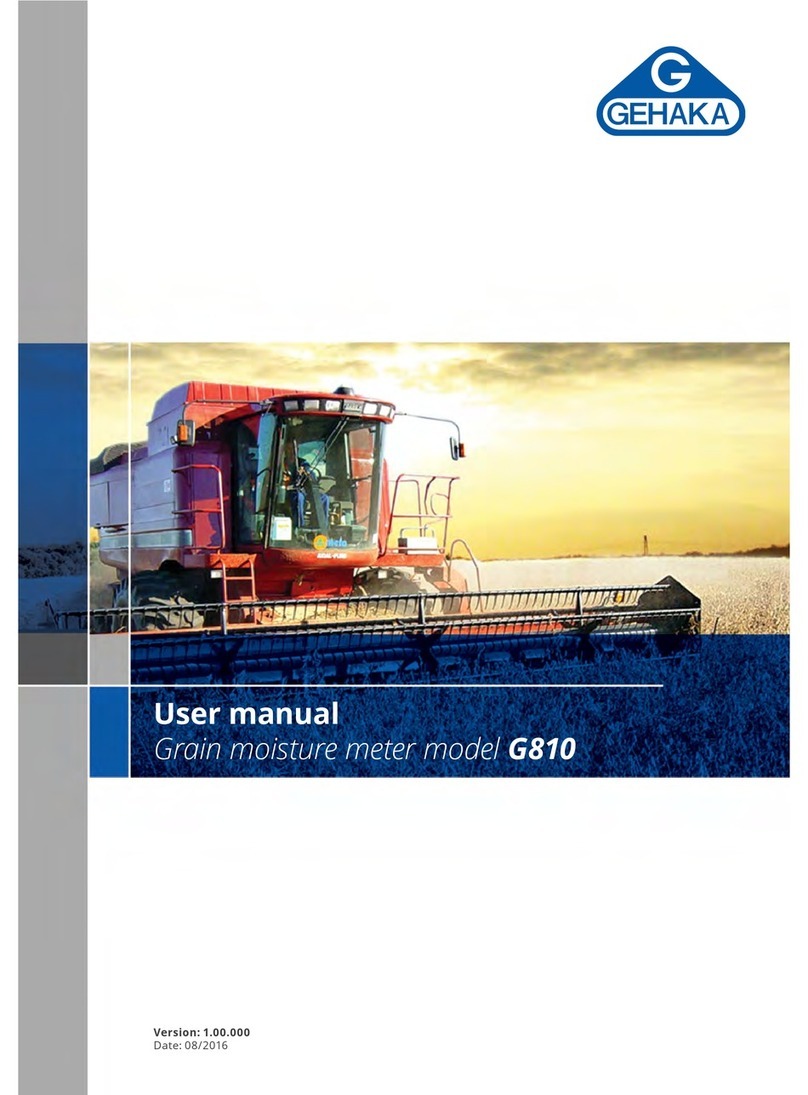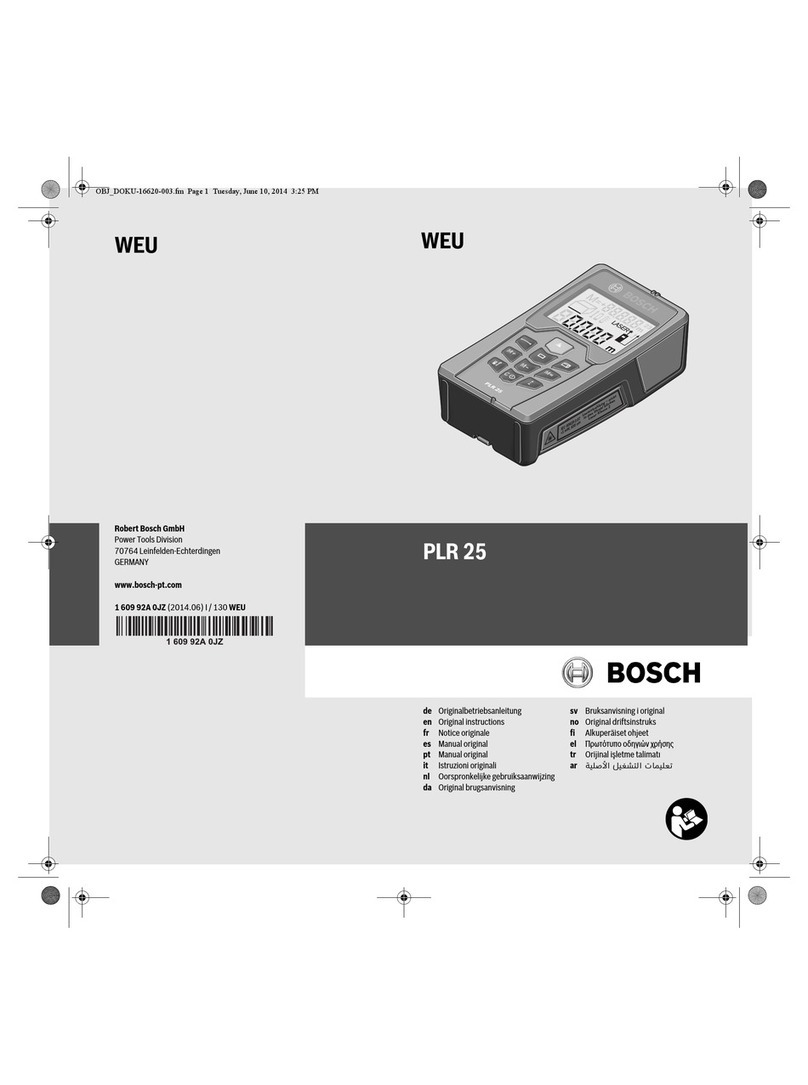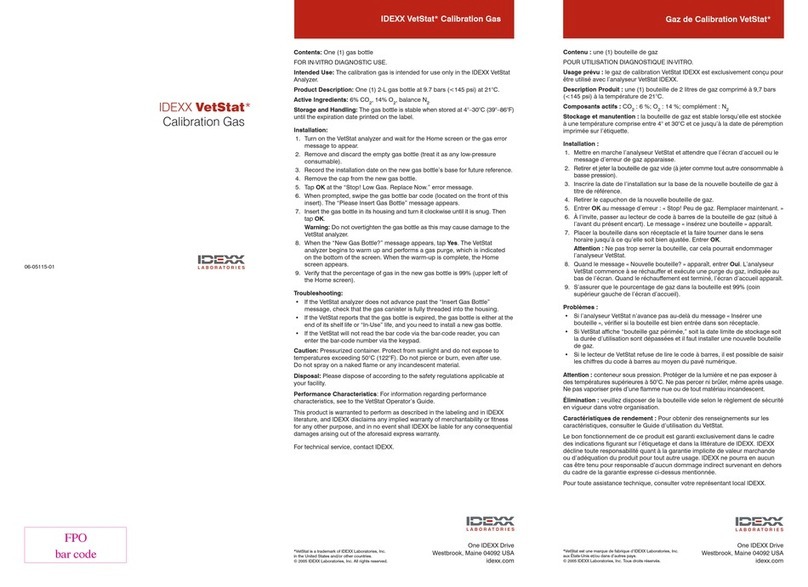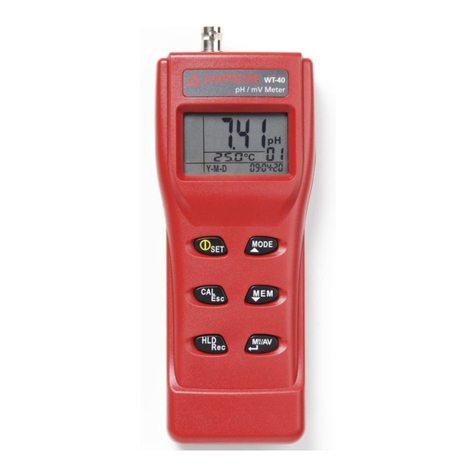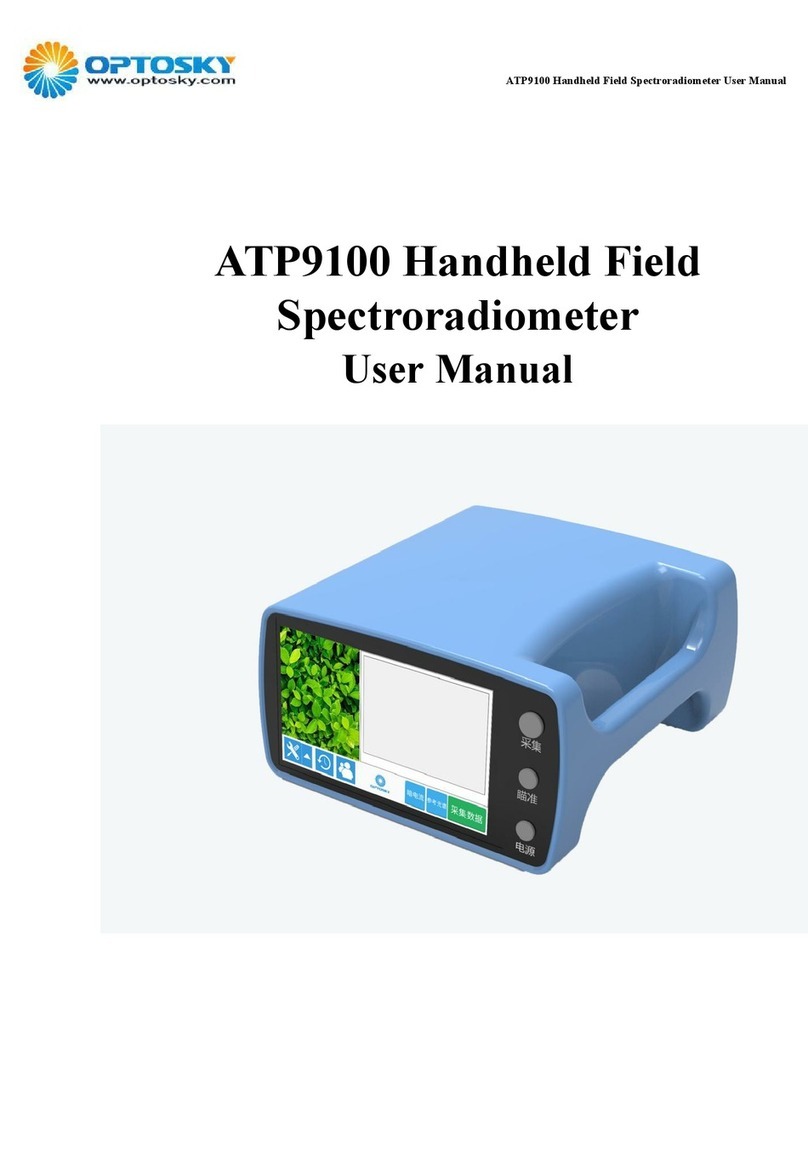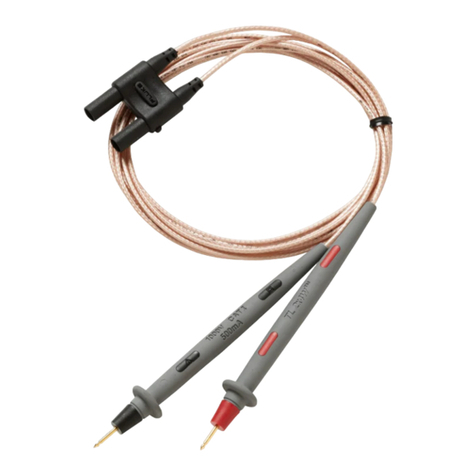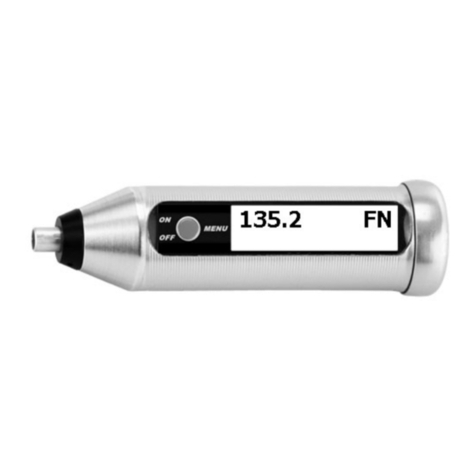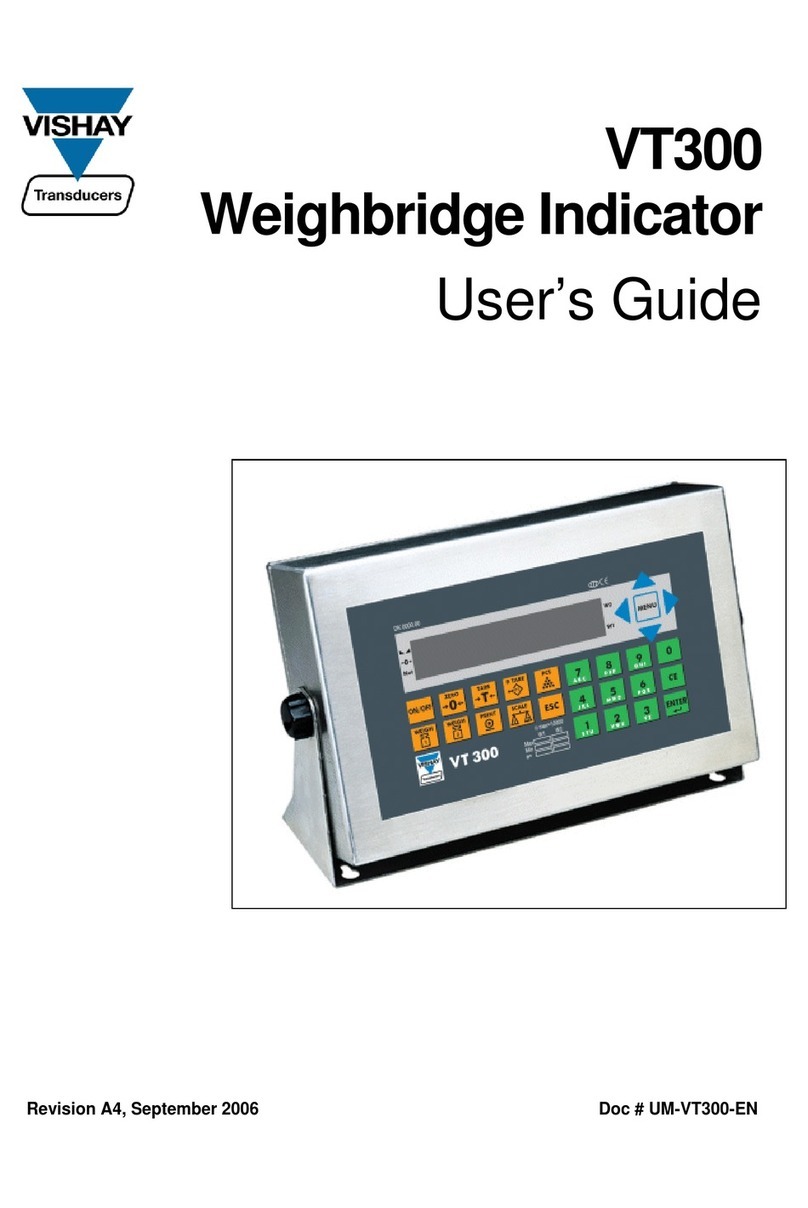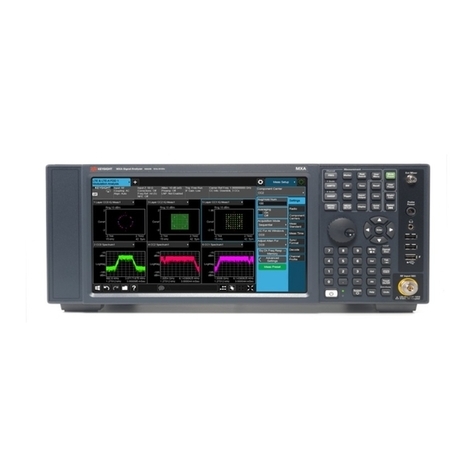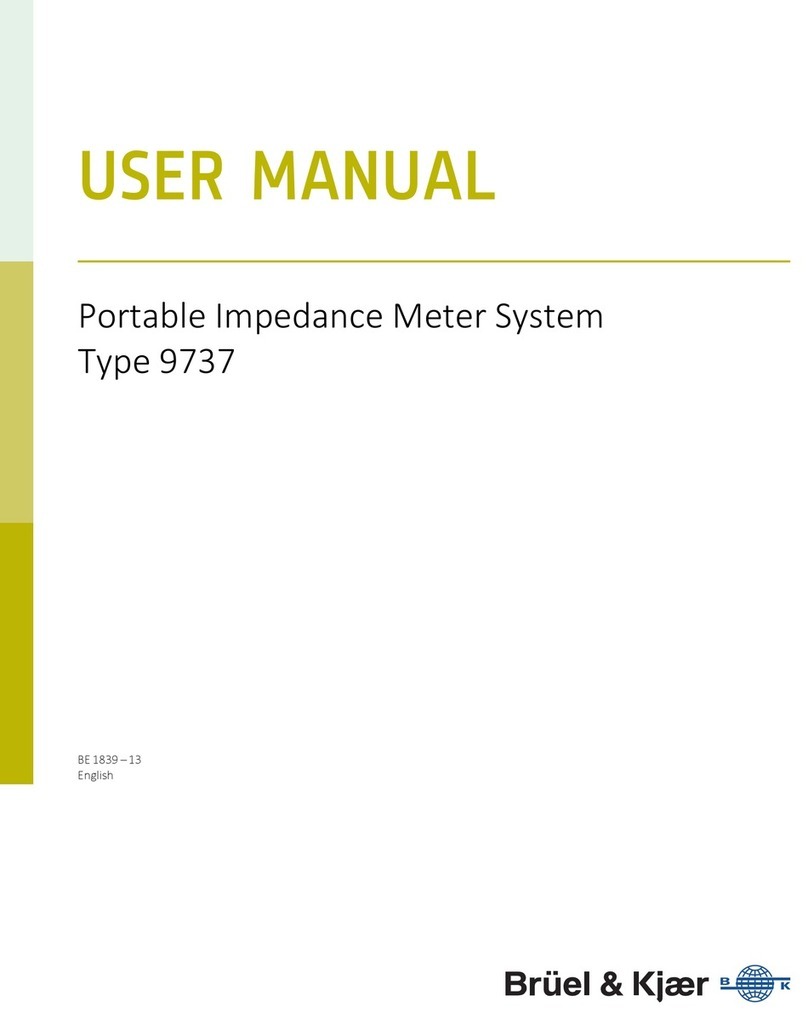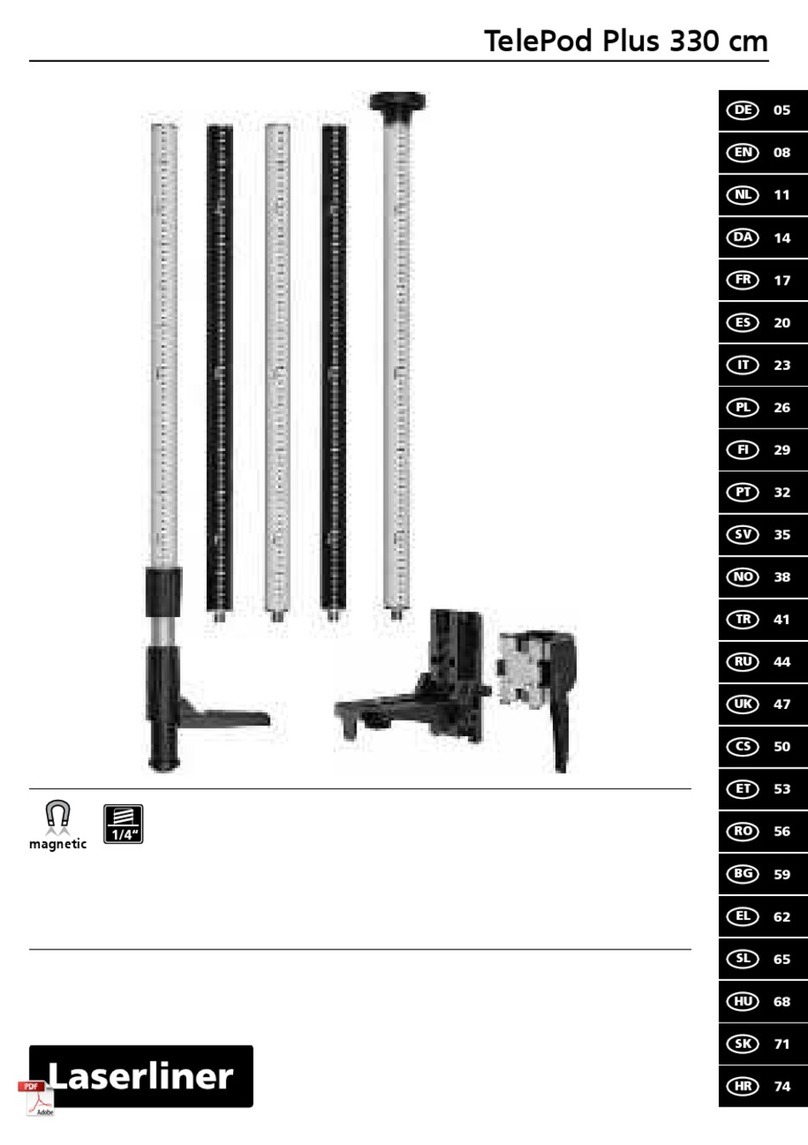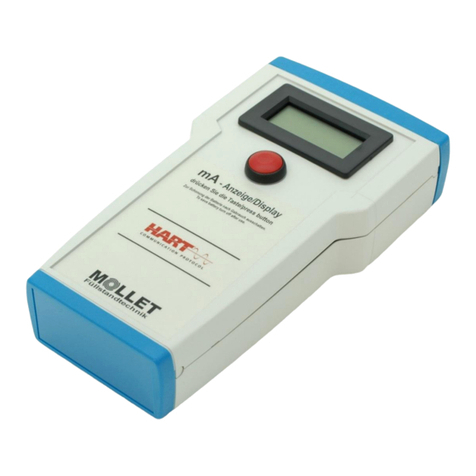Emtek P100 User manual

P100 USERS MANUAL JUN2014v03
1
P100 Portable Microbial Air Sampler
Users Manual
Contact Us for Customer Service and Technical Support
EMTEK,&LLC&
1500 Kansas Ave., Suite 3-F
Longmont, CO 80501
Website: http://www.emtekair.com
Phone: 877.850.4244
Email: sales@emtekglobal.com
Fax: 303.223.2804

P100 USERS MANUAL JUN2014v03
2
Table of Contents
Section 1 Specifications ......................................................................................................................................... 4
Section 2 General Information ............................................................................................................................. 5
2.1 Document Description...................................................................................................5
2.2 Copyright.......................................................................................................................5
2.3 Disclaimer .....................................................................................................................5
2.4 License Restriction........................................................................................................5
2.5 P100 Technical Description ..........................................................................................6
2.6 Safety Notices ...............................................................................................................8
2.6.1 Referenced Hazard Information........................................................................8
2.6.2 Precautionary Labels..........................................................................................9
2.7 Standards and Regulation .............................................................................................11
2.7.1 CE Declaration of Conformity ........................................................................11
2.7.2 21 CFR Part 11 Compliance............................................................................11
2.8 Warranty .......................................................................................................................11
2.9 Calibration ......................................................................................................................11
Section 3 Product Introduction……………………………………………………………………………….…...12
3.1 Feature Summary ........................................................................................................12
3.2 Unpacking or Packing .................................................................................................13
3.2.1 Component Checklist ......................................................................................13
3.2.2 Optional Accessories.......................................................................................14
3.2.3 Component Carry Case ...................................................................................15
3.2.3.1 Loading the Carrying Case...............................................................16
Section 4 Installation………….…………………………………………………..…………………………...…...17
4.1 Wiring Safety Information............................................................................................17
4.2 Electrostatic Discharge (ESD) Considerations ...........................................................17
4.3 Charging the P100 Battery..........................................................................................19
4.4 Electrical & Data Connections....................................................................................20
Section 5 P100 Description.................................................................................................................................. 21
5.1 P100 Front View .........................................................................................................21
5.2 P100 Rear View ..........................................................................................................22
Section 6 Quick Start Guide ............................................................................................................................... 23
Section 7 Operating Instructions........................................................................................................................ 24
7.1 Touch Screen Description and Function .....................................................................24
7.1.1 Setup Screen (Main Menu) ...........................................................................25
7.1.2 Run Display. ..................................................................................................26
7.1.3 Set Sample Parameters..................................................................................27
7.1.4 Printer............................................................................................................28

P100 USERS MANUAL JUN2014v03
3
7.1.5 Alarm (Flow) & IR Remote Settings ............................................................29
7.1.6 Delay, Test, & Hold Settings.........................................................................30
7.1.7 Site Descriptions............................................................................................31
7.1.8 Date & Time Settings ....................................................................................32
7.1.9 Data Output (Printer & USB) ........................................................................33
7.1.10 Calibration (Due & Notification)...................................................................35
7.1.11 Administrative (Admin & User)....................................................................36
7.1.11.1 Administrative Control Options.......................................................39
7.1.12 Unit Information (Firmware Version) ...........................................................41
7.1.13 Save (Sample) Programs (Select, Add, Delete).............................................42
7.3 IR Remote Control ......................................................................................................44
7.3.1 Loading the Batteries into the Remote Control ...............................................44
7.3.2 Operating the P100 with the Remote Control..................................................45
7.4 Alarms/ Warning Screens............................................................................................46
7.5 Optional Thermal Printer Operation ...........................................................................47
7.6 HEPA Filter & Battery Pack .......................................................................................50
7.7 Touch Screen Sensor Calibration................................................................................51
7.8 Transporting the P100 Sampler...................................................................................51
Section 8 Network Operation of the P100 ......................................................................................................... 52
Appendix A P100 Sampler - General Sampling Procedure ................................................................................. 53
A.1 P100 Operating Principles...........................................................................................53
A.2 Materials......................................................................................................................54
A.3 Maintenance Inspection...............................................................................................54
A.4 P100 Sampler Assembly Set-Up and Testing .............................................................56
A.5 Storage and Transport .................................................................................................61
Appendix B Suggested P100 Sampler Sanitation................................................................................................ 62
B.1 Materials......................................................................................................................62
B.2 Sanitization Procedure.................................................................................................62
Appendix C Optional Sampling Components ..................................................................................................... 65
C.1 Compressed Air/Gas Sampling Kit.............................................................................65
C.2 Horizontal Flow Inlet ..................................................................................................67
C.3 Remote Sampling Inlet................................................................................................68
C.4 Remote Exhaust Kit ....................................................................................................69
Appendix D Suggested Sample Submission and Results Recording................................................................. 70
Feller Calculation Tables………………………………………………………………...…...71
Appendix 1 CE Declaration of Conformity......................................................................................................... 72
Appendix 2 Warranty............................................................................................................................................ 73

P100 USERS MANUAL JUN2014v03
4
Section 1 Specifications
P100 Air Sampler Controller
Motor Type
Blower Motor
Display/Interface
Two Color LCD with Touch Screen (Blue on White), CPU
Current Firmware Version
1.083, 1.092 (or later versions, until otherwise revised)
Sample Time/Volume
Variable (User Defined), Maximums: 120-minutes/3396 Liters* @ 28.3 LPM, 30-min/3000L @ 100 LPM
Delay/Hold Times
Variable (User Defined)
Sample Flow Rates
28.3 or 100 liters per minute (LPM), or 1 cubic feet per minute (CFM)
NOTE: Requires separate inlet covers for the 28.3 (1 CFM) and 100 LPM Sample Rates
Flow Rate Control
Electronic, Closed-Loop, Mass-Flow Control
Test Media (Plates)
Size: 90mm Test Plates (Plastic Petri Dishes) Fill Height: 15 to 50ml (standard to double, or high fill plates)
Printer (Optional)
Thermal Label or Paper
Control System (CPU)
Microprocessor Controlled (32bit PIC Processor)
Memory
512kb Flash Program , 128kb RAM Data, 1mb Sample Runs, 512kb EPROM Calibration Set Points
Unit Equipment ID/Number
User Defined/Selectable
Site Descriptions
User Created/Deleted/Selectable
Program Descriptions
User Created/Deleted/Selectable (Includes: Sample Rate, Volume/Time, Flow/Volume Units, Delay/Test/Hold)
Sample ID
Unique System Generated (Unit Serial # + 5 digit string)
Input/Output
USB Client 1.1, Ethernet 10BaseT-/100-BaseT
Audible Alarm
Internal (with User Volume Control)
Alarms
Flow Alarm +5% (On/Off)
Dimensions
LxWxH: 7.5 x 5.5 x 6.5 inches (190 x 134 x x 165 cm)
Enclosure Materials
Inlet Base & Base Cover: 6061 Aluminum (Clear Anodized) / Cover: KydexTM with MicrobanTM / Handle: Aluminum
Inlet Cover Materials
6061 Aluminum, 28.3 LPM (1 CFM) Inlet Clear Anodized, 100 LPM Inlet Blue Anodized, 300 Holes/Inlet Cover
Exhaust Filter
HEPA Filter, 0.2 micron, Replaceable
Weight
5.4 Pounds 2.5 Kilograms
Tripod Mount
Bottom Cover, ¼-20 Threading x 0.250” (6.4 mm) Depth
Battery Pack
8 Cell Lithium Ion, 4400mAh, 14.8V
AC/DC Power Supply
Input: 100-240 VAC, 50/60 Hz,130VA-168VA 1.4 AMPS / Output: DC 18V 3.6A
Battery Charging/Life
Full Battery Charge from Full Discharge: Approximately 2.5 hours
Battery Life: Approximately 10 Hours @ 28.3 LPM & 6 Hours @ 100 LPM
Operating Range
5-40º C, 10-80% RH, non-condensing*; Indoor Use; Max Altitude 6560 feet (2000 meters)
*Note: As temperature increases from 30 to 40º C, humidity range drops from 80 to 50% linearly.
Calibration
Flow Rate (28.3/1 CFM and/or100 LPM)
Calibration Frequency
User Defined (Recommended every 6-12 months)
Verification
Sample Timer
Verification Frequency
User Defined (Recommended every 6-12 months)
Gas Compatibility
Air and inert gases such as carbon dioxide, nitrogen, and argon
Installation Category
Category 1
Pollution Degree
1 and 2

P100 USERS MANUAL JUN2014v03
5
Section 2 General Information
2.1 Document Description
Document EMTEK.P100.001v01 (First Edition). October 2013.
This document remains the official reference source for all revisions/releases of this product until rescinded by an
update, including current and updated versions of the operating firmware and software.
2.2 Copyright
© 2013 by EMTEK, LLC. All rights reserved.
2.3 Disclaimer
It is the policy of EMTEK, LLC to improve this manual and the products it describes as new technology,
components, software, and firmware become available. EMTEK, LLC reserves the right to make changes to any
products herein at any time without notice. In some instances, photographs and figures are of equipment
prototypes. Therefore, before using this document, consult your EMTEK, LLC representative for information that
is applicable and current. The information in this manual is believed to be accurate. However, EMTEK, LLC
assumes no responsibility for any inaccuracies that may be contained in this manual. In no event will EMTEK,
LLC be liable for direct, indirect, special, incidental, or consequential damages resulting from any defect or
omission in this manual, even if advised of the possibility of such damages. In the interest of continued product
development, EMTEK, LLC reserves the right to make improvements in this manual and the products it describes
at any time, without notice or obligation. No part of the contents of this manual may be reproduced or
transmitted in any form or by any means without the written permission of EMTEK, LLC.
2.4 License Restriction
The purchase or use of an EMTEK, LLC product does not convey a license under any patent, copyright,
trademark, or other intellectual property right of EMTEK, LLC or third parties.

P100 USERS MANUAL JUN2014v03
6
2.5 P100 Technical Description
The P100 (EMTEK, LLC Portable 100) is a portable, battery operated, microbial air sampler. Its enclosure is comprised of a
top cover that is made of KydexTM that lies over an aircraft grade aluminum base plate. The KydexTM cover contains
MicrobanTM, an antimicrobial agent that minimizes and/or reduces the growth of microbial contaminants that may come in
contact with the KydexTM cover. The user interfaces with the P100 through a two color LCD touch screen for entering user
defined sample parameters and for the initiation and termination of sample runs. During operation the LCD displays key
sample run information, as well as a visual sample progress indicator.
The P100 is offered with two (2) sample flow rates: 28.3 LPM (1 CFM) and 100 LPM. The highest flow rate, 100 LPM,
allows for the collection of a cubic meter of air in 10-minutes, while the 28.3 LPM (1 CFM) flow rate takes approximately 35
minutes to capture a cubic meter. The flow is controlled through a proprietary CPU control system, which offers automated
flow control of the two defined flow rates. Flow rates are calibrated and set against traceable standards through the use of
an external software program and may not be altered through the user interface on the unit. Sample rates and total volume
sampled maybe displayed and output in Cubic Feet, Liters, or Cubic Meters (only for total volume). Flow alarm settings are
available for the flow rates, which will produce both an audible and visual alarm during operation and may be output to the
optional printer upon completion/termination of the sample period. Alarm occurrences are maintained within the systems
internal memory with the associated sample parameter information until the 500 sample run memory buffer is cleared.
The P100 operates with separate sieve impaction inlet covers for each of the two flow rates, 28.3 LPM (1 CFM) and 100
LPM. The inlet covers include a 300 hole pattern with appropriate inlet hole sizing for each flow rate to assure optimal
physical and biological recovery capabilities. Each inlet cover includes a distance gauge, which works in conjunction an
adjustable media stage to assure an ideal distance is maintained between the inlet cover and test media surface for appropriate
microbial particulate capture. The air sampler uses standard 90mm agar based microbial test plates (e.g., Trypticase Soy Agar
(TSA)). During testing the sampled air volume drawn through each air sampler is HEPA filtered before being exhausted
within the P100.
The P100 software, allows for sampling periods of up to 120-minutes (or 120 Cubic Feet/3396 Liters/3.4 Cubic Meters) at
the 28.3 LPM sample rate, while sample times are limited 30-minutes (or 106 Cubic Feet/3000 Liters/3 Cubic Meters) at 100
LPM. While the stated time periods, or total sample volumes are allowed by the P100, EMTEK strongly suggests that all
sampling periods employed by be qualified by the user to verify appropriate organismal recovery. In addition, the P100
offers the user the capability of entering an initial sample delay, as well as hold and test periods for each sample run. This
initial sample delay allows the user time to exit the immediate area of the sample location, while the hold and test period
settings allows for intermittent sampling of an area or process for an extended time period, as determine appropriate by the
user. For an example, the user may set an initial delay period of 3-minutes and then opt to sample for 5-minute periods with
5-minute hold periods between each 5-minute sampling period, which will occur for a period up to the maximum total
sampling period defined for the flow rate chosen. If the flow rate chosen is 28.3 LPM, and the maximum active sampling
period set is 60-minutes, this would allow for twelve (12) 5-minute test periods, followed by eleven (11) 5-minute hold
periods, for a total plate exposure time of 118-minutes (including the 3-minute initial delay). This would result in a total of
60-minutes of active sampling. The blower motor powers down during hold periods. Again, EMTEK recommends the
user qualify any sampling plan used, to include sample delay, and test/hold periods.

P100 USERS MANUAL JUN2014v03
7
The P100 maintains key sample run parameter data within its internal memory, which is maintained until the memory buffer
is cleared by the user or unit administrator, and/or if the 500 sample run memory buffer capacity is exceeded. Based on
administrative options, the unit will either allow no more runs to be taken with the unit until the run data is reviewed and
cleared, or it will remove the oldest run stored with each new run take. The data maintained in the system includes
set/actual flow rate, set/actual sample volume, sample start/end times, set delay, test and hold period, equipment and serial
numbers, calibration date and due date of the controller/air sampler(s), user defined site description, user ID, and alarms
during sampling. An alphanumeric keypad is provided on the touch screen for entering user defined site
identifiers/descriptions. All sample runs are date and time stamped and are also assigned a unique sample identification string
which is comprised of the units assigned serial number and a non-repeating character string up to 99,999 samples. The run
data cannot be altered within the CPU system of the P100. It may only be output (via USB Stick, or Printer), viewed (via
LCD, or PC), or cleared from the system.
Sample runs on the P100 can be initiated through either the P100 touch screen Run Display screen, the supplied Infrared
Remote (IR Remote), or by remote PC operation (optional). Using either the P100 display, IR Remote, or PC (optional), the
user can START, PAUSE, RESUME, or STOP a sampling session. The IR Remote allows for these functions at a distance
of up to 40-Feet, or approximately 12 meters, with line of site to the P100 IR Receiver window located just above the touch
screen display on the P100. The supplied single IR remote can operate up to 5 P100’s with different IR ID#’s set on the unit
(user selectable IR ID#’s 1 through 5).
There are several options available for the P100. This includes a handheld thermal printer, Remote PC/Ethernet based
operation, horizontal flow inlet, compressed air/gas testing kit, remote exhaust kit, and remote sampling kit. The thermal
printer is battery operated and can utilize both paper or label stock available from EMTEK. There are two options for the
label stock. This includes labels that use black mark detection with backing and a tear of perforation, or liner-less labels (no
backing-self sticking) without tear of perforations. The printer outputs the defined key sample parameter data following
each run (if desired). Additionally, the user can output duplicate labels/data from sample data stored in the memory buffer
based on a requested number of samples. The Remote PC Operations software will allow single or multiple unit control via
Ethernet connection. The horizontal flow inlet allows for testing in areas of horizontal air flow such as horizontal flow
Laminar Air Flow Hoods/Benches. Compressed air/gas testing can be performed at 100 LPM with the addition of the
Compressed air/gas adapter and EMTEK’s Microbial High Pressure Diffuser. The remote exhaust kit allows for attachment
of tubing to exhaust sampled air away from, or outside of the location being sampled (e.g., Isolator, ISO 5 Filling Line, LAF
Hood, etc.). The custom carrying case allows for transport of the standard P100 kit, as well as key optional accessories.

P100 USERS MANUAL JUN2014v03
8
2.6 Safety Notice
Please read this entire manual before operating this equipment. Pay attention to all danger, warning and caution
statements. Failure to do so could result in serious injury to the operator or damage to the equipment. To make
sure that the protection provided by this equipment is not impaired, do not use or install this equipment in any
manner other than that specified in this manual.
English
DANGER: Electric Shock or Electrocution Hazards
1. Disconnect all power sources before servicing the P100
2. Do not disassemble the P100 controller to attempt any repairs.
3. Contact EMTEK, LLC or other qualified service personnel if the unit malfunctions.
4. Do not submerse the P100 controller or any sampler in any liquid.
Français
DANGER: un choc électrique ou des dangers d'électrocution
1. Débranchez toutes les sources d'alimentation avant d'intervenir sur le P100
2. Ne démontez pas le contrôleur P100 pour tenter une réparation.
3. Contacter EMTEK, LLC ou autres membres du personnel d'entretien qualifié en cas de
dysfonctionnement de l'appareil.
4. Ne pas plonger le contrôleur P100 ou échantillonneur dans un liquide.
2.6.1 Referenced hazard information
English
DANGER
Indicates a potentially or imminently hazardous situation which, if not avoided, will
result in death or serious injury.
Français
DANGER
Indique une situation potentiellement dangereuse ou imminent qui, si elle n'est pas évitée,
entraîner la mort ou des blessures graves.
English
WARNING
Indicates a potentially or imminently hazardous situation which, if not avoided,
could result in death or serious injury.

P100 USERS MANUAL JUN2014v03
9
Français
AVERTISSEMENT
Indique une situation potentiellement dangereuse ou imminent qui, si elle n'est pas évitée,
pourrait entraîner la mort ou des blessures graves.
English
CAUTION
Indicates a potentially hazardous situation that may result in minor or moderate injury.
Français
ATTENTION
Indique une situation potentiellement dangereuse qui mai entraîner des blessures plus ou modérée
blessure.
Important Note: Indicates a situation which, if not avoided, may cause damage to the instrument. Information that requires
special emphasis.
Note Importante : Indique une situation qui, si non évité, peut provoquer le dommage à le instrument. Les informations qui
exigent l'accentuation spéciale.
Note: Information that supplements points in the main text.
2.6.2 Precautionary labels
Read all labels and tags attached to the instrument. Personal injury or damage to the instrument could occur if not
observed.
English
Electrical equipment marked with this symbol may not be disposed of in European public disposal
systems after 12 August of 2005. In conformity with European local and national regulations (EU
Directive 2002/96/EC), European electrical equipment users must now return old or end-of life
equipment to the Producer for disposal at no charge to the user.
Note: For return for recycling, please contact the equipment producer or supplier for instructions on
how to return end-of-life equipment, producer-supplied electrical accessories, and all auxiliary items
for proper disposal.

P100 USERS MANUAL JUN2014v03
10
Français
Les équipements électriques marqués de ce symbole mai ne pas être éliminés dans les systèmes européens
de disposition du public après le 12 août 2005. En conformité avec les réglementations locales
européennes et nationales (Directive européenne 2002/96/CE), les utilisateurs européens
d'équipements électriques doivent maintenant retourner vieux ou en fin de vie des équipements au
producteur pour l'élimination, sans frais pour l'utilisateur.
Remarque: Pour le retour pour recyclage, s'il vous plaît contacter le producteur ou le fournisseur du
matériel pour obtenir des instructions sur la façon de revenir en fin de vie des équipements,
producteurs-fournis accessoires électriques, et tous les éléments auxiliaires pour une élimination
appropriée.
English
This is the safety alert symbol. Obey all safety messages that follow this symbol to avoid potential
injury. If on the instrument, refer to the instruction manual for operating on or safety information.
Français
Ceci est le symbole de sécurité. Respectez tous les messages de sécurité qui suivent ce symbole afin
d'éviter d'éventuelles blessures. Si sur l'instrument, se reporter au manuel d'instructions pour
l'exploitation ou de l'information sur la sécurité.
English
This symbol indicated the presence of devices sensitive to Electro-static Discharge (ESD) and
indicated that care must be taken to prevent damage with the equipment.
Français
Ce symbole indique la présence de dispositifs sensibles à Electro-Static Discharge (ESD) et a
indiqué que les soins doivent être prises pour prévenir les dommages aux équipements.
English
This symbol indicates that a risk of electrical shock and/or electrocution exists.
Français
Ce symbole signifie qu'il existe un risque de choc électrique et/ou d'électrocution existe.

P100 USERS MANUAL JUN2014v03
11
2.7 Standards and Regulation
2.7.1 CE Declaration of Conformity
See Appendix 1
2.7.2 21 CFR Part 11 Compliance
Sample Parameter Information and Electronic Records
The P100 Central Processing Unit (CPU) stores sample parameter information for up to 500 sample runs in the
internal memory. This memory is not removable or alterable by the user. The sample parameter information
maintained in the system for each run includes: Serial#, Equipment#, Building/Room (if entered through PC
software), Start Date, Start time, End time, Average Flow, Total Volume, Total Run Time, Delay (duration), Hold
(duration), Sample (duration), User ID, Run ID (system generated), Site (ID), Hi Flow (duration), and Low Flow
(duration). The stored sample parameters can be cleared/deleted by the user (if allowed through Admin control),
or administrator, but cannot be edited. Further, sample parameter information of a specific sampling event
cannot be selectively deleted or altered by the user. The P100 can re-print sample parameter information using the
optional thermal printer. The user can select the number of previous samples to be printed.
The sample parameter information stored in the internal memory of the P100 controller can be either printed to
the optional thermal printer, output to a USB stick for further transfer, or transferred to an external computer
through an Ethernet connection and optional PC based software. The sample parameter information can be
deleted but cannot be altered while residing within the internal memory of the P100 CPU. This sample
parameter information may be exported from the internal memory. EMTEK, LLC does not provide software
utilities to comply with the requirements of 21 CFR Part 11 after the data is transferred from a P100 controller to
an external source. Users that are subject to FDA regulations are responsible for maintaining compliance with 21
CFR Part 11 after the data is transferred from the P100 to an external source.
2.8 Warranty
EMTEK, LLC provides a 2-Year Limited Warranty- See Appendix 2
2.9 Calibration
EMTEK and your local area distributor offer calibration services and other options for your P100 Microbial Air
Samplers. A 6 or 12 month (annual) calibration cycle is recommended. Contact EMTEK or your distributor for
calibration questions, service, or options.

P100 USERS MANUAL JUN2014v03
12
Section 3 Product Introduction
The P100 is a state-of-the-art Portable Microbial Air Sampler for use with the EMTEK, LLC line of microbial
sampling devices. It uses mass flow control to accurately regulate the selected air-flow for precise measurement
of the collected volume.
3.1 Feature Summary
Touch Screen Interface
User-friendly touch screen for intuitive operation.
Storage Functions
Internal memory for the storage of user sample sites, sample runs, sampling programs, calibration points,
user and administrative ID’s and passwords.
Thermal Printer:
An optional thermal paper/label printer can output the captured sample parameter information such as
the site description, unit identification, set flow rate, actual flow rate, sample volume collected, user ID,
and high/low flow alarms.
Network/Input Functions:
Supports calibration programming, remote PC based operation, data transfer, and firmware updates
•Ethernet Port:
oRemote Data Printer
oRemote PC based unit control, data viewing/output via optional PC based software
oUnit Calibration via PC based calibration software
•USB Port:
oFirmware Updates
oData Transfer to USB Stick
IR Remote Control:
•Supports Start / Stop of the sample period
•Supports Pause / Resume of the sample period
•Operates up to five (5) P100 Units

P100 USERS MANUAL JUN2014v03
13
3.2 Unpacking or Packing the P100 & Components
Remove all items from the carrying case, and/or other shipping container and inspect them for damage. Make sure
that all of the items listed are included (Fig 3.2.1), dependent upon purchase options. If any of the items not
3.2.1 Instrument Component Checklist – Standard P100 Package Components
Item#
Descriptions
Quantity
1
P100 Portable Microbial Air Sampler
1
2
Power Supply (AC/DC Power Block/AC Adapter Cord)
1
3
Infrared Remote (IR) Control
1
4
USB Stick-8 GB (Contains Users Manual and other applicable
Documents, and for P100 Sample Run Data Output
1
5
Plastic Carrying Case with Component Insert
1
6
NIST Traceable Calibration Report (Not Shown)
1
1-P100 2-Power Supply 3-IR Remote
4-USB Stick
5- P100 Customer Carrying Case

P100 USERS MANUAL JUN2014v03
14
3.2.2 Optional Components
Fig. #
Item Description
1
Extra Inlet Cover(s) (28.3 or 100 LPM)
2
Portable Printer Kit: Portable Printer (1), Power Adapter (1), Ethernet to RJ11
Adapter Cord (1), Label Rolls (3)
3
Horizontal Flow Inlet (w/3 O-Rings)
4
Compressed Air/Gas Sampling Kit (100 LPM): 100 LPM Microbial HPD (6061
Aluminum), P100 Inlet Adapter (w/3 O-Rings), HEPA Exhaust Filters (2), Sanitary
Clamp/Gasket (304SS/PTFE), ½ID Tubing (30”)
Fig. 1-Inlet Cover (28.3 LPM Shown) Fig. 2-Portable Printer Kit
Fig. 3- Horizontal Flow Inlet Fig. 4-Compressed Air/Gas Kit
NOTE: See Appendix C for description/use of P100 Optional Components

P100 USERS MANUAL JUN2014v03
15
3.2.3 Component Carry Case
General Description
The P100 comes packaged in a customer carrying case (Fig. 1). The case has custom cut outs in the
insert, which will safely hold for transport, and shipping. The insert will hold all of the standard P100
components, as well as one set of optional accessories, with the exception of the Compressed Air/Gas
Sampling Kit. This will come in a separate package.
Fig. 1 - P100 Component Carrying Case

P100 USERS MANUAL JUN2014v03
16
3.2.3.1 Loading the Carrying Case
GENERAL: Place the components in the carry case at the designated locations depicted below (Fig. 1).
NOTES:
1) The printer power supply/charger, and Ethernt to RJ11 cable should be placed in the lower slot,
before the printer is put in place, as shown in the images to the left of the case.
2) The P100 power cord, for the P100 power supply/charger, should be placed in the P100 Charger
opening, and then the power supply/charger block, as shown in the images to the right of the case.
3) Assure the P100 is powered off before closing the carrying case lid!
Fig. 1 - P100 Component Placement
P100
Extra Inlet
Cover
Horizontal
Inlet (& Inlet
Adapter)
-Printer
-PWR supply
-Ethernet to
RJ11 Cable
P100
Charger
IR
Remote
Label Rolls
USB
Drive
Calibration Report

P100 USERS MANUAL JUN2014v03
17
Section 4 Installation
English
Danger
Only qualified personnel should perform the tasks specified in this section.
Français
Danger
Le personnel seulement qualifié devrait exécuter les tâches spécifiées dans cette section.
4.1 Wiring safety information
Follow all warnings and notes when making wiring connections to the instrument (Safety information on page 8).
English
DANGER
Electric shock hazard. Always disconnect power to the instrument when making electrical
connections.
Français
DANGER
Un choc électrique risque. Toujours couper l'alimentation de l'instrument lors des branchements
électriques.
4.2 Electrostatic discharge (ESD) considerations
Important Note: To minimize hazards and ESD risks, maintenance procedures not
requiring power to the P100 should be performed with power removed.
Delicate internal electronic components can be damaged by static electricity,
resulting in degraded instrument performance or eventual failure.
Note Importante: Pour minimiser les dangers et les risques de l'EDD, les procédures d'entretien
non nécessitant une alimentation à la P100 devrait être exécuté avec la
puissance retirés. Interne sensible composants électroniques, peuvent être
endommagés par l'électricité statique, résultant en instrument une
dégradation des performances ou de l'échec éventuel.

P100 USERS MANUAL JUN2014v03
18
The manufacturer recommends taking the following steps to prevent ESD damage to
your instrument:
• Before touching any instrument electronic components (such as printed circuit cards
and the components on them) discharge static electricity from the body. To discharge
static electricity, touch an earth-grounded metal surface such as the chassis of an
instrument, or a metal conduit or pipe.
• To reduce static build-up, avoid excessive movement. Transport static-sensitive
components in anti-static containers or packaging.
• To discharge static electricity from the body and keep it discharged, wear a wrist
strap connected by a wire to earth ground.
• Handle all static-sensitive components in a static-safe area. If possible, use
anti-static floor pads and work bench pads.

P100 USERS MANUAL JUN2014v03
19
4.3 Charging the P100 Battery
Battery Description: 8 Cell Lithium Ion, 4400mAh, 14.8V, battery pack.
Charge Time: Approximately 2.5 Hours to a full charge
Run Time (Approximate): @ 28.3 LPM, 12 Hours / @ 100 LPM, 6 Hours
Battery Life Indicator: 0-100%
To Charge the P100,
1) Attach the required adapter plug to the power supply/charger shown below.
2) Plug the charger into an accessible 100-240 VAC, 50/60 Hz wall outlet
3) Attach the charger to the P100 as shown, as follows:
P100 DC Power Input Port Attach DC Power Input Plug
4) If the P100 is powered on the Green LED in the upper left corner of the LCD window frame will blink when
the unit is charging. You can check the charged status of the unit, by viewing the battery life percentage
indicator during the charge cycle.
5) If completely discharged, the unit will take approximately 2.5 hours to fully charge. Check the battery life
indicator to determine the charged status of the unit.

P100 USERS MANUAL JUN2014v03
20
4.4 Electrical/Data Connections
English
DANGER
Electric shock hazard. Always disconnect power to the instrument when making electrical
connections.
Français
DANGER
Un choc électrique risque. Toujours couper l'alimentation de l'instrument lors des branchements
électriques.
Fig 4.3.1
P100 Rear/Side View
Connections:
1. DC Input Port: AC/DC Power Supply (Battery Charging, Power Connected Operation)
2. USB Port: Data Output to USB stick, firmware updates
3. Ethernet Port: Calibration, Optional Printer Connection, Remote PC Operations
2
1
3
Table of contents
Popular Measuring Instrument manuals by other brands
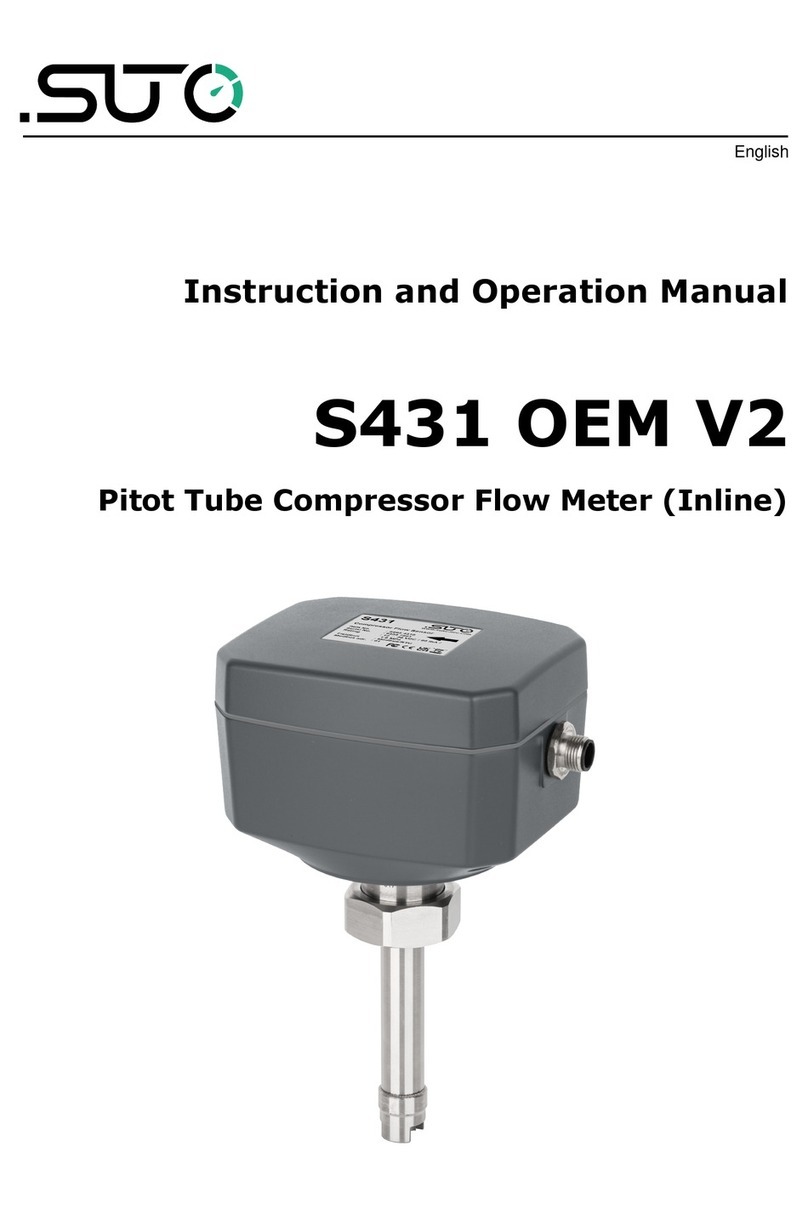
SUTO
SUTO S431 OEM Instruction and operation manual

Mitsubishi Electric
Mitsubishi Electric ME96NSR Operator's manual
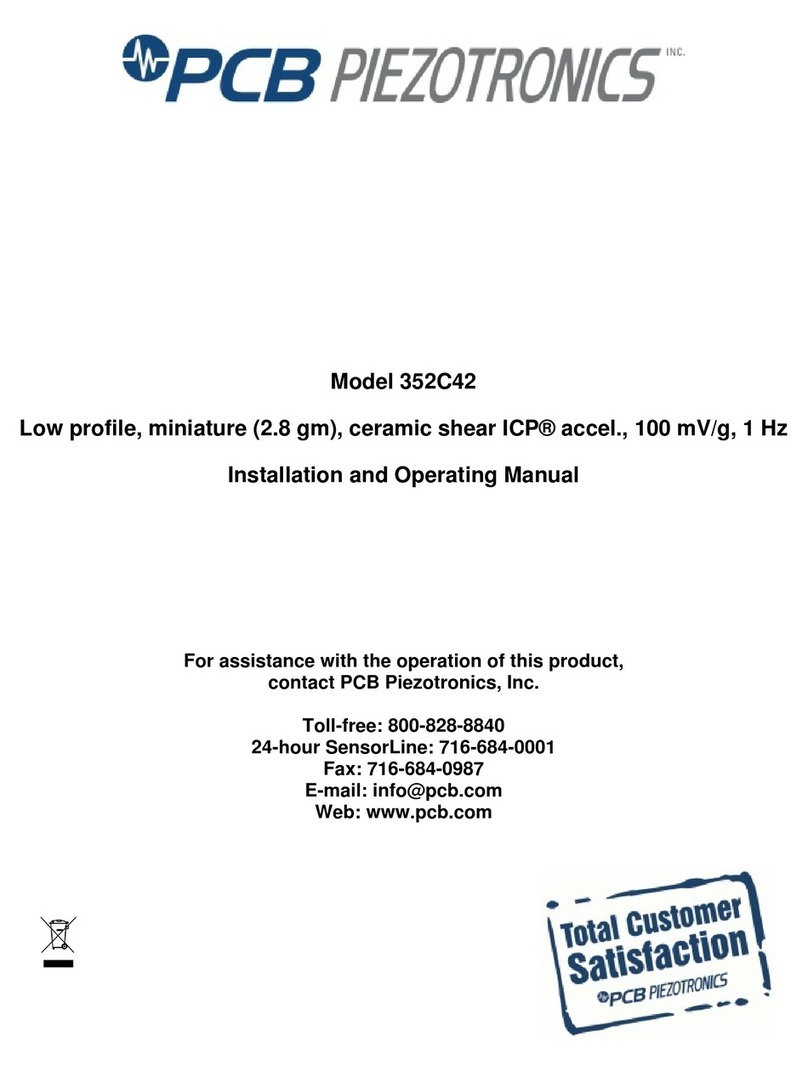
PCB Piezotronics
PCB Piezotronics 352C42 Installation and operating manual
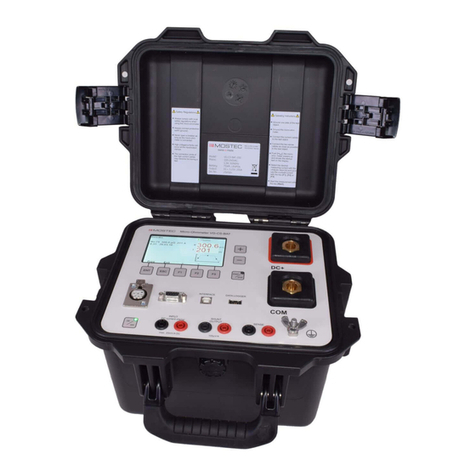
Mostec
Mostec VG-BAT Series operating manual

TESTO
TESTO 510 instruction manual
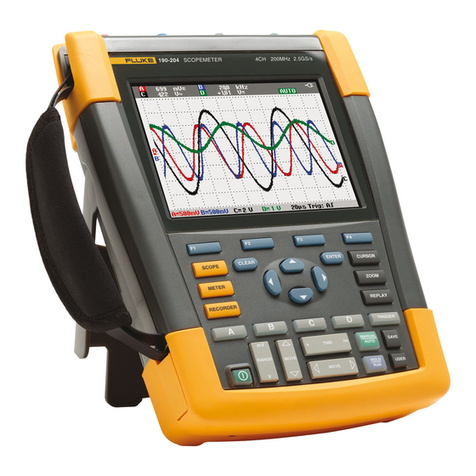
Fluke
Fluke ScopeMeter 190-104 Service manual
